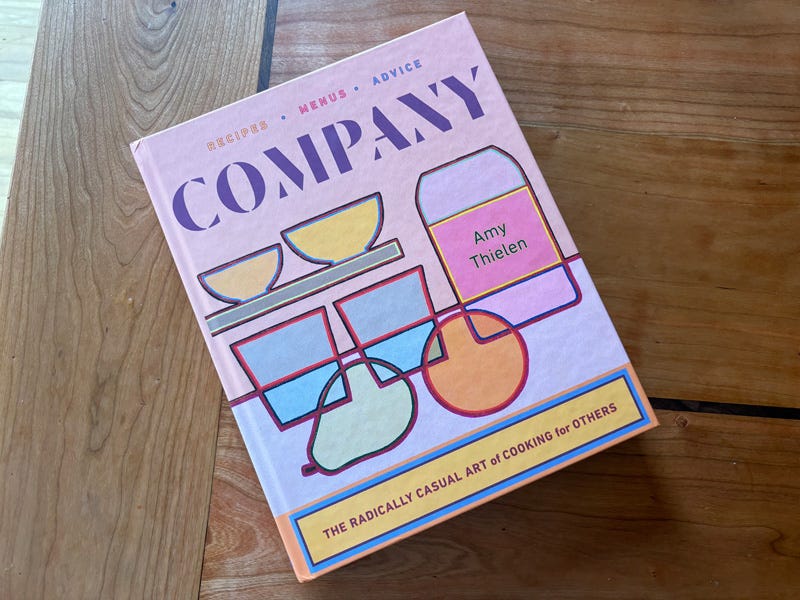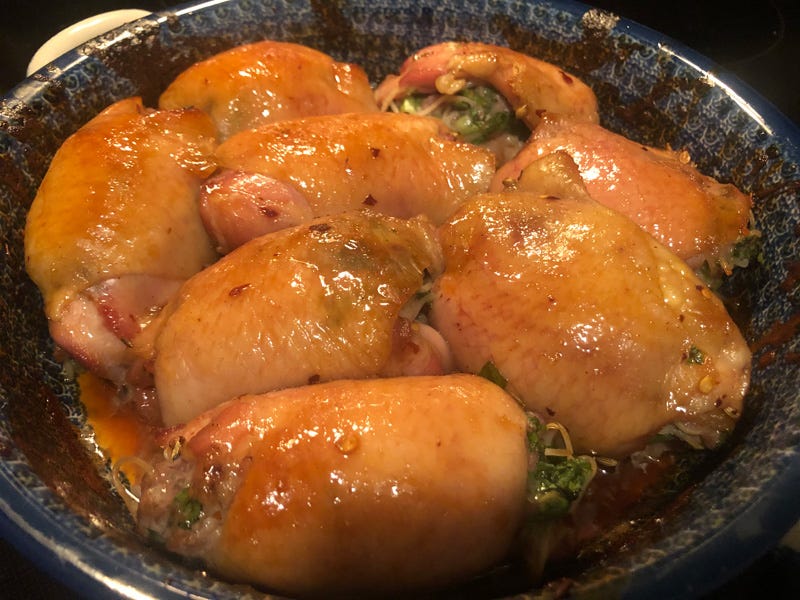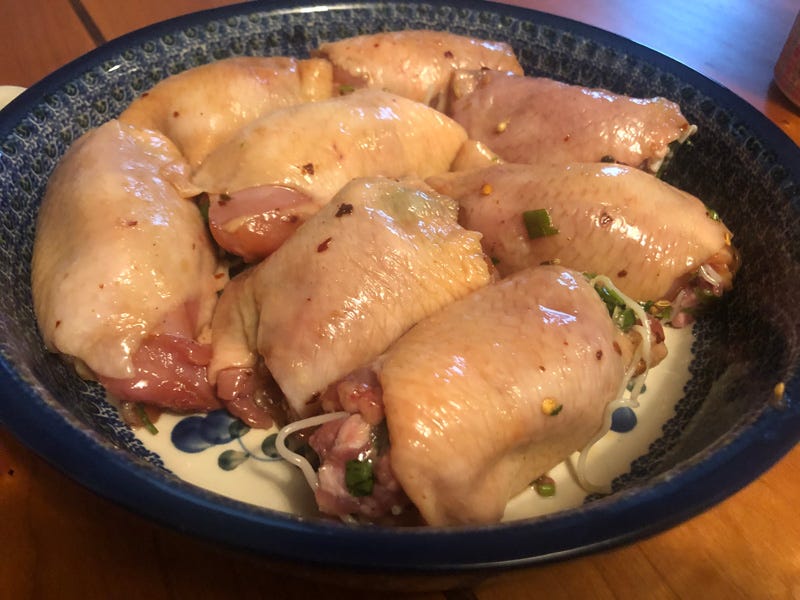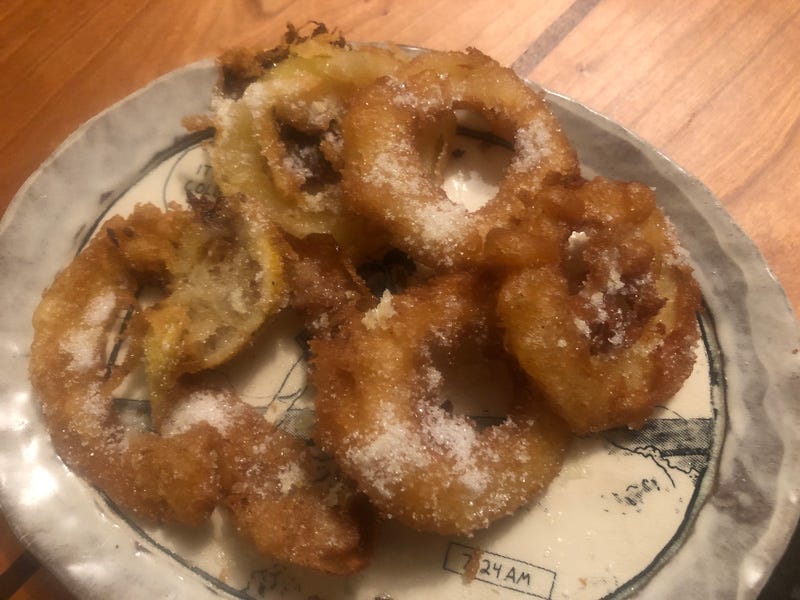THE COOKBOOK TEST #0010: COMPANY BY AMY THIELEN
INSTALLMENT #0010 (FREE) / COOKING FOR OTHERS / A CONVERSATION WITH AMY THIELEN / PORK-STUFFED CHICKEN THIGHS / APPLE FRITTO MISTO
Dear Readers,
This installment of THE COOKBOOK TEST may be my favorite yet. It’s an opportunity for me to think and write about what may be my favorite thing in the world: cooking for other people with love. And it was an opportunity for me to talk to a down-to-earth, local-to-Minnesota, global expert in the field of cooking for other people with love.
Chef and author Amy Thielen is the author of the James Beard-award winning cookbook The New Midwestern Table, and her memoir, Give a Girl a Knife. She was the host of Heartland Table on Food Network, and her family owns and operates Thielen Meats of Pierz, MN, one of our state’s many outstanding country butcher shops. (The two biggest under-told stories of Minnesota are its incredible Southeast Asian food scene and its remarkably good, could-pass-muster-in-Germany country meat store situation.)
Her new book is called COMPANY: THE RADICALLY CASUAL ART OF COOKING FOR OTHERS. It’s a menu book, one of my favorite cookbook formats - instead of presenting recipes in isolation, each menu has a major theme (like “Spangler family Christmas Eve,” or “Deer camp feast” or “Annual birthday blowout for my brother”) and all of its recipes revolve around one another to make a harmonious evening of complementary foods.
This makes sense to me: it’s how we cook for others and how we entertain. One of my favorite parts about hosting people is debating with my wife Becca what we’re going to serve - what recipes? What sides? What’s the flow? What can we make ahead? What should we scale up, and by how much? How sober should everybody be by the end of the night? What are the kids eating?
It’s work, but it’s joyous work, and nothing makes me happier than to have my feet up halfway through an evening with friends at home, feet up on something, sipping a cocktail and finally forgetting all the shopping, prep, and staging that made the evening possible. It’s a magic feeling, and one that Company captures quite well, with its emphasis on achievable warmth and harmonious menus over Instagram ready visual impact and “it recipe” glossy sheen.
Anyhow, let’s get to it - this is going to be fun.
at your service,
James
COMPANY: THE RADICALLY CASUAL ART OF COOKING FOR OTHERS
BY AMY THIELEN
WW Norton / 352 pages / 2023 / $40
Amy Thielen’s new cookbook Company walks a tightrope that most of its peers can’t navigate: it’s authoritative and rich enough to be useful to veteran cooks, but clear enough and accessible enough to be welcoming to beginners. The difficulty of its recipes scale from “eminently achievable” to “challenging but plausible” - there’s nothing in Company that is a redundant snooze-fest nor something that’s so technically challenging that it’s almost guaranteed to be an expensive disaster in the making.
But in some ways the recipes are sort of beside the point. The menu-driven perspective of Company means that it’s as much about the flow of the recipes and the day itself as it is about any one dish. In that respect, it’s a particularly useful book for readers who want to launch themselves into the sphere of ambitious entertaining, because it’ll help you see all the various parts that flow into the greater whole that defines a celebratory menu. Thielen is also good about contextual points (shopping, prep work, specific thoughts about specific ingredients) that get lost in books that are less serious or less detailed. Dishes live and die on fine points, and those points make the cut in Company.
JAMES NORTON: What does the word 'hospitality' mean to you?
AMY THIELEN: It means making people feel welcome. When I go to someone else's house, sometimes I feel indebted, or like: 'oh, I feel bad they're doing all of this for me', you know what I mean?
It's so deeply Minnesotan! But I think the goal is to comfort that and to assuage that feeling. To enforce that you want to give, and it doesn't come with strings, and there's nothing transactional about it. It's just in the moment.
JN: I thought your menu concept really leant itself well to welcoming people in and giving them a complete thought for the evening.
AT: I like that, 'a complete thought.' That's really nice. There's that familiarity and repetition - it does break down any weirdness or barriers people have about going somewhere else.
I don't have proof that people used to entertain more, but I'm thinking way back in the day, I think so. The pandemic really - because we were Zooming into each other's rooms - that had something to do with allowing more casual and frequent get-togethers.
JN: My grandma entertained constantly and that was very different from my parents' generation. Nostalgia for that, or wanting to bring that back... seeing friends more frequently and casually... I was struck by your account in the book of going visiting and seeing people's houses and farms.
AT: This book is exactly what most of the people I live around do. It's kind of how socializing is done.
JN: When did it come to you to do set menus instead of individual recipes?
AT: I pitched and sold it as a menu book. My agent wanted a proposal, and I emailed her and was like: 'I waste so much time cooking.' And she was like, 'ha ha, very funny,' but the truth I was ... well, not wasting time, but spending a lot of my time having people over and having dinner parties. I'd just put out my memoir and gone on tour, and this is what I was doing to kick back and relax, right?
Then I realized, why didn't I think about these menus I regularly make...? Sometimes I would incorporate one or two [recipes] but the idea, I think I'd fallen prey to the idea that I had to make these very hot ‘dance single’ recipes.
What I was doing was making these buffets where everything went together on a plate, and I was seeing the real creativity that can come together on a plate. People don't talk about that very much.
JN: It's like creating an album that flows rather than a hot single.
AT: It's pretty analogue, right? But also - it's what my mom concerned herself with, most of the time. 'Well, we're going to have corn... and chicken, do we want beans, or greens? Or a Caesar salad?' She would follow us into the bathroom as teenagers, we'd be in the shower and she'd be like: 'What are we having? What are we going to do?' And we were like: 'God, we don't care!' But we did care.
JN: With the vast universe of recipes available on the Internet, why are cookbooks still relevant?
AT: I think that people buy my book because they like the way I write about food. I've been very isolated - and I don't read a lot of food media. Less and less. Fewer and fewer sites all the time. I think I've just been in it long enough that I don't want the influence. So the feedback I'm getting is like: 'Your writing sounds a little different. It's not very derivative.' It took a world to create it, so let's let people get into that world.
I have an office next to my kitchen with four or five hundred cookbooks, so every Sunday I go in there and start pulling books off the shelf and try to get into somebody's vibe. So for me, that's the function cookbooks have.
Also there's an idiosyncratic way of cooking that every cookbook author has. Especially if we resist standardizing the recipes too much. I am not a fan of the standardized recipe, where the style is the same from person to person and recipe to recipe. You have to say, 'add the salt here,' and you have to put the time before the visual cue.
I really flouted the rules [in Company] and my editor was 100% behind it. When the recipes are written according to me and my world, you get a sense of how I cook. I really learned to cook from people like Paula Wolfert, because her recipes were also written in that personal way. You know what I mean?
JN: Yeah. Specifically in the last couple of years with AI coming on the scene and crapping all over everywhere, the value of a knowledgeable and warm human voice to me has gone up.
AT: AI, that whole thing is really scary. I think all our books are in there. It just ate the Internet. But here's the thing about recipes, too. Even before AI, they were not copyrightable. The idea that you own a recipe has always been controversial.
Think about back in the day, I wrote about my grandmother in one of the chapter introductions - one of the ways people got recipes was in newspapers and columns. Or community cookbooks. You clip those out of the newspaper, and even if you didn't change anything, if you made it, it became yours, you know? I don't know when this idea of owning a recipe began, but in a way I think about it as - can we really own land? Should we own a recipe? That's a weird question for a cookbook author to ask...
HT: But while the recipes are part of it, a lot of it is the context for how a recipe is used, and the reason this version is good, and the nuances of picking the ingredients...
There you go, yes.
JN: Those are all outside of the canonical 'here's how you make it' text of a recipe, and are super important.
AT: The ingredient thing you mentioned is so incredibly important. That was so hard because: 'Gosh, what if people don't have green beans like this, you know?' I just thought, what would I tell myself to do? In the fried chicken menu, I wrote, 'if it's not summer and there aren't good beans, make something else.' Don't attempt this with leathery store mid-winter green beans.
JN: What three cookbooks in your home are the most beaten to a pulp due to overuse?
AT: There is a book, an Italian book from the '60s... it's by Ada Boni. I go to that book [The Talisman Italian Cookbook] and it has very few photos. But it explains things... I feel like there's an authorial presence, even though there isn't an 'I,' there's no first person at all.
When French Women Cook, by Madeleine Kamman, is a really great book that feels fresh somehow. It's classic French stuff, but there are little ways that make it feel super original. And I love her writing voice - it's always a little bossy.
And here's a book on my counter I just pulled out yesterday - it's also by WW Norton and my editor, Carolyn Phillips, All Under Heaven, recipes from the 35 cuisines of China. It's an amazing Chinese cookbook. She's great.
PORK-STUFFED CHICKEN THIGHS
I’m sort of a sucker for anything-stuffed-with-anything recipes (up to but not including the highly overrated Turducken, which really defeats the purpose of roasting and eating celebratory birds.) So when I spotted Thielen’s Asian-inflected pork-stuffed chicken thighs recipes, I knew I had to try it.
It turns out it’s one of the author’s favorite dishes from Company.
“I've made them for so long,” says Thielen. “Even before I wrote The New Midwestern Table I used to make them.” The recipe, says Thielen, is a shorthand for her experience eating and cooking with Asian ingredients. “It was inspired by eating at Hmong markets, and me reading about Indonesian [food] ... it's not from a specific place in Asia, let's say that.”
“I worked in a Chinese restaurant for a year - I was a sous chef at [Restaurant] 66 [in New York City], and my fellow sous chefs had lived in Asia or had family from there, so all the family meals, all the ingredients were Chinese,” she says.
To me, the recipe feels quintessentially St. Paul, I tell her - it reminds me of doing dining crawls down University Avenue, tasting everything the Hmong, Vietnamese, Cambodian, and Thai restaurants had to offer. (“Very much!” says Thielen.)
When I made this recipe I was really pleased by how easily it came together - it looks intimidating (particularly deboning the chicken thighs) but it was actually quite smooth and straightforward. Thielen’s instructions on deboning are clear and detailed, and walk even kitchen beginners through the process (see below.)
Because I bought a one-pound increment of ground pork, I ended up scaling the filling up by 25% and using the excess to make incredibly tasty meatballs that I sauteed in oil and served on rice noodles with chopped scallions, cilantro, and a bit of chili sauce and hoisin (above).
The finished dish looked princely, a collection of richly browned lacquer packets stuffed with herbal-inflected surprises. And, to my surprise, it was a big hit with my kids (10 and 5 years old) who responded well to the complex but ultimately mellow flavors and the dish’s touch of honey sweetness.
Pork-Stuffed Chicken Thighs
From Company: The Radically Casual Art of Cooking for Others by Amy Thielen
Serves 6 to 8
Chicken Thighs
4 teaspoons coriander seeds
1 teaspoon black peppercorns
½ teaspoon anise or fennel seeds
½ teaspoon cardamom seeds
1 teaspoon hot pepper flakes
3 pounds skin-on chicken thighs (10 to 11)
½ cup honey
¼ cup soy sauce
2 tablespoons fish sauce, preferably Red Boat brand
½ teaspoon fine sea salt
5 makrut lime leaves
Ground Pork Filling
One 1-ounce block mung bean noodles (sai-fun)
12 ounces ground pork
1 teaspoon sugar
1 heaping cup minced fresh cilantro (stems included)
⅔ cup minced scallions (both white and green parts)
1 ½ tablespoons grated ginger
2 teaspoon toasted sesame oil
½ teaspoon fine sea salt
½ teaspoon freshly ground black pepper
Toast the coriander, peppercorns, anise or fennel seeds, and cardamom in a dry pan over medium heat until fragrant, about 2 minutes. Remove the heat and let cool slightly, then add the pepper flakes and finely grind in a spice mill (or clean coffee grinder.)
Remove the bones from the chicken thighs: A serrated steak knife seems to work best. Cut down along both sides of each thigh bone to expose it, then slide your knife under the bone, up toward the ball joint, angling it up, to free it. Scrape down all meat with your knife until you get to the joint, then slip your knife around it and cut out the bone. Run your fingers over the meat, feeling for knobs of bone or cartilage, and remove them if you find any. If you’re new to deboning, just do it as quickly as you can and don’t worry about leaving a little meat on the bone, because that’s the nature of it. Transfer the deboned thighs to a wide bowl. If you have the time, drop the bones, along with any trim pieces, into a saucepot to make a quick stick. (Or freeze the bones for a future stock-making session.)
Add the honey, soy sauce, fish sauce, salt, makrut leaves, and ground spice mixture to the thighs, toss to coat, and leave to marinate - at least 1 hour at room temperature, as long as 8 in the refrigerator.
Preheat the oven to 375 F.
For the filling, cook the mung bean noodles in boiling water for just 2 minutes and drain them in a sieve. Run a little cold water over them - not too much, you want them to remain sticky - and put the sieve on top of the dry pot to steam dry.
Using scissors, cut the noodles into 2-inch lengths. Combine the ground pork, sugar, cilantro, scallions, ginger, sesame oil, salt, and pepper in a bowl, add the noodles, and mix together with your hands.
Drain the chicken and pour the liquid into a small frying pan to reheat later for glazing. Lay a few thighs skin side down on a baking sheet, and fill the cavities with about 2 to 3 tablespoons of pork filling each - as much stuffing as the thighs will hold. Roll each thigh closed and arrange them, huddled snugly together, in the center of a large baking sheet. Repeat with the remaining thighs and pork filling.
Bring the marinade to a boil and cook for a minute to thicken it. Brush the tops of the thighs with a generous coating of marinade and roast for 10 minutes.
At this point, the juices will have begun to seep from the chicken; carefully tip up the pan and spoon the collected juices back into the marinade. Bring the marinade back to a boil, then brush the chicke with another thick coat of it and roast for another 10 minutes. Brush the thighs one more time with the marinade, using all of it, and continue to roast until the skin is deeply caramelized and the pork filling inside the chicken runs hot and clear when piercved with a fork, another 10 to 15 minutes (for a total of 35 minutes in the oven.)
Transfer the stuffed thighs to a platter and serve.
APPLE FRITTO MISTO
One of the astounding things about being a food writer is that no matter how many years go by, and how many books I read or things I make, I still find myself surprised by new ideas and flavors on a regular basis. The culinary universe feels nearly infinite. Case in point: this dessert from Company, which fries up apples, lemons, and apple peels to create a dessert that is delicious and not quite like anything I’ve experienced before.
This mixed fry-up is surprisingly light, delicate, and bright thanks to the liberal use of lemon sugar. The fried apple rings actually resemble apple cider doughnuts but are considerably more nimble and bright, while hit much the same sweet spot. And the peels are one of the best parts of this recipe, as they're a crispy, crunchy, chewy textural delight. The lemon slices had a bit of a tough rind when we tried them but the intense, delightful kick of citrus that their interiors provided more than compensated for the textural challenge.
This recipe is adapted from Company. My version below omits sage leaves from the original recipe (not through any resentment of sage; I actually just forgot to include them, and Thielen swears by them so don’t hesitate to add them to the mix if you’re in the mood) and it reduces the amount of tonic water to avoid batter that is too thin to grip the apple slices.
Apple and Lemon Fritto Misto
Serves 3-4
1 Meyer lemon, scrubbed
1 Tbsp sugar
1/2 pound tart apples (2-3)
Oil for deep frying (4 cups)
7/8 Cup all purpose flour
2 Tbsp rice flour
1/2 tsp sea salt
3/4 cups tonic water
1/2 cup white wine
1 large egg
1/2 cup sugar mixed with grated zest of 1 lemon
Cut the ends off the lemon, then slice it 1/8 inch thick. Remove the seeds, and toss the lemon slices with the sugar and macerate for 30 minutes.
Peel the apples to leave long peels, and then slice the apples into horizontal circles about two nickels thick. Cut out the seedy centers. Save the peels!
For the batter: whisk the flours and salt together. Add half the tonic, the white wine, and an egg, and mix loosely with a fork, leaving some small lumps. Check your batter thickness - it should be gluey and stick even to the apple slices. It's likely too thick at this point - add a bit more of the tonic water until it's thick and adhesive, but not thin and runny.
Heat your oil to about 360 F in a deep fryer or cast iron. Dip your apple slices, peels, and lemon slices into the batter and fry them for about 4-5 minutes, flipping them halfway through, until they're deep brown. Remove them to a paper towel-lined baking sheet with a wire rack in it, and dust them liberally with lemon sugar while hot. Serve while warm.
THE VERDICT ON COMPANY
(***BUY IT*** / BORROW IT / SKIP IT / BURN IT)
This cookbook exemplifies the reason people still write and buy cookbooks - it’s rich with context, voice, and experience, and it’s organized in a way that’s both autobiographical and highly usable for readers entertaining guests. It also contains recipes unlike the standard repertoire of stuff sloshing around the Internet - there are some legitimately fresh and intriguing new things in Company, and they’re tested enough and written clearly enough that they’ll actually work when you try them out at home.






